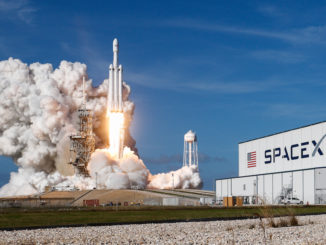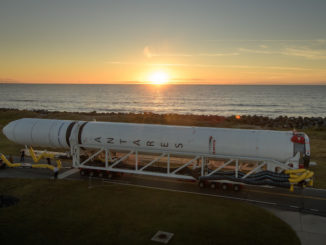
A technical issue with the United Launch Alliance Atlas 5 rocket that will send NASA’s $2.4 billion Perseverance rover toward Mars has pushed the mission’s launch date back to no earlier than July 30, nearly two weeks into a month-long window for the rover to head to the Red Planet, or else face a two-year delay.
NASA confirmed the launch delay to no sooner than July 30 in a statement Tuesday.
“Due to launch vehicle processing delays in preparation for spacecraft mate operations, NASA and United Launch Alliance have moved the first launch attempt of the Mars 2020 mission to no earlier than July 30,” NASA said. “A liquid oxygen sensor line presented off-nominal data during the Wet Dress Rehearsal, and additional time is needed for the team to inspect and evaluate.”
ULA performed the Wet Dress Rehearsal on June 22. The exercise involved rolling the Perseverance rover’s Atlas 5 launcher out of its vertical integration hangar to Cape Canaveral’s Complex 41 launch pad, then loading the rocket with kerosene, liquid hydrogen, and liquid oxygen propellants.
The launch team practiced countdown procedures, testing the Atlas 5’s systems before halting the pre-launch sequence seconds before ignition of the rocket’s RD-180 main engine.
After draining cryogenic propellants from the rocket, ULA returned the Atlas 5 to the Vertical Integration Facility south of pad 41 on June 24 to await the arrival of the Perseverance rover, the centerpiece of NASA’s Mars 2020 mission. ULA ground crews are also assessing the liquid oxygen sensor line that behaved unexpectedly during the Wet Dress Rehearsal.
The launch window July 30 opens at 7:50 a.m. EDT (1150 GMT). The Atlas 5 assigned to launch the Perseverance rover will fly in a configuration with four strap-on solid rocket boosters, a single-engine Centaur upper stage, and a 5.4-meter-diameter (17.7-foot) payload fairing.
The Mars 2020 mission was originally scheduled for launch July 17, the opening of an interplanetary launch period stretching several weeks in length. But several problems have delayed the launch date, eating into the limited period NASA has to vault the Mars 2020 mission off Earth on a trajectory toward Mars.
The launch period for the Mars 2020 mission originally ended Aug. 5, but NASA said earlier this month that additional analysis of the rover’s trajectory extended the available launch dates through Aug. 11. On Tuesday, NASA said flight analysis teams have added more days to the launch period, which now extends to Aug. 15.
Engineers are examining if the launch period may be extended further into August, according to NASA.
Spaceflight Now requested an interview Tuesday with NASA’s launch director for the Mars 2020 mission, but a NASA spokesperson could not provide the interview opportunity.
Nevertheless, the clock is ticking for the Mars 2020 team. Assuming the launch period closes Aug. 15, the mission has now used up nearly half of its launch period this year. The next chance to launch the Perseverance rover after this August will come in 2022.
“When you talk about Earth and Mars being on the same side of the sun, that happens once every 26 months,” said NASA Administrator Jim Bridenstine in a Mars 2020 pre-launch press conference earlier this month. “So it’s very expensive, if we have to take Perseverance and put it back into storage for a period of two years, it could cost half a billion dollars.”
NASA initially delayed the launch to July 20 after a problem with a crane held up assembly of the Atlas 5 rocket inside the VIF. A contamination concern issue with ground support equipment in NASA’s Payload Hazardous Servicing Facility — the ultra-clean room where the Perseverance rover is being readied for launch — delayed encapsulation of the spacecraft inside the Atlas 5’s aerodynamic payload shroud.

With the contamination concern resolved, NASA and ULA intended to transport the Mars 2020 spacecraft inside its payload fairing to the VIF on Saturday for installation on top of the Atlas 5 rocket.
But ULA needed extra time to address liquid oxygen sensor line issue, and a NASA spokesperson said Tuesday she did not know when the Mars rover could be transported to the Atlas 5 hangar. After the spacecraft is mated to the Atlas 5 rocket, teams need around 25 days to ready the vehicle for launch.
Tory Bruno, ULA’s president and CEO, tweeted Tuesday that the Atlas 5 and Mars 2020 teams have “been working through a couple of challenges.”
He identified the ground facility issue at the PHSF, and characterized the liquid oxygen system problem as a “misbehaving pressure sensor.” He also wrote that current status of the COVID-19 pandemic in Florida has been a concern.
Once the spacecraft is hoisted atop the Atlas 5 rocket, ground crews will install the Perseverance rover’s plutonium-fueled power source through a port in the side of the Atlas 5’s payload fairing. The Mars rover — about the size of a small car — will be powered by the Multi-Mission Radioisotope Thermoelectric Generator, or MMRTG, throughout its mission.
Assuming it launches this year, the Perseverance rover will land on Mars on Feb. 18, 2021, aiming for a region known as Jezero Crater. Scientists say Jezero is home to an ancient dried-up river delta, where the rover will get to work with its scientific instruments studying Martian geology and climate.
One of the rover’s primary missions is to gather dozens of rock and soil samples inside hyper-sterile tubes, which the rover will hermetically seal and drop in caches on the Martian surface for retrieval by a future robotic sample return mission.
Email the author.
Follow Stephen Clark on Twitter: @StephenClark1.



